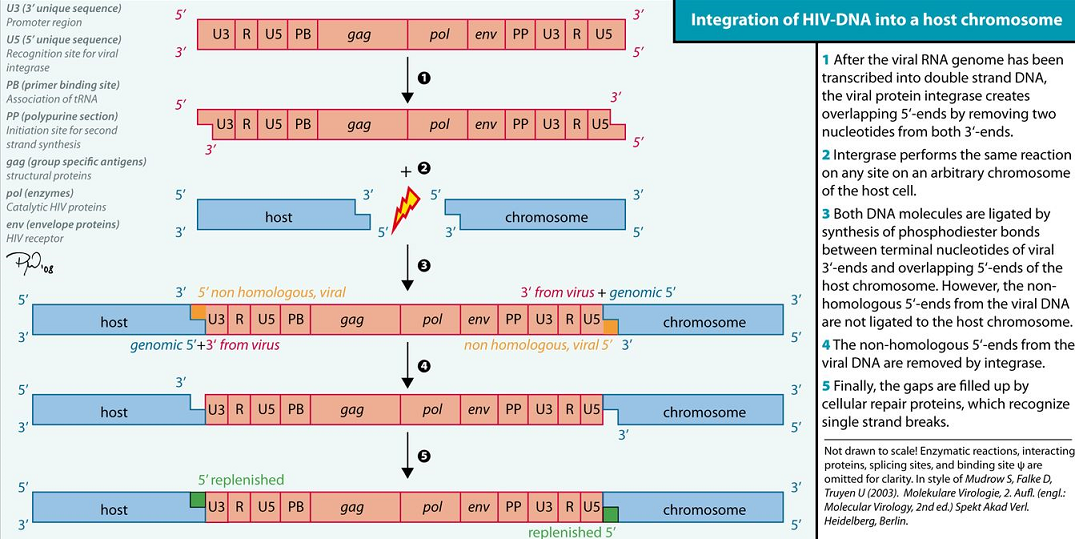|
|
|
Medical Pharmacology Chapter 36: Antiviral Drugs
Antiviral Drugs
Anti-viral drugs with activity against HIV (Human Immunodeficiency Virus)
Introduction: Human Retroviruses continued: Viral Replication
Viral DNA integrates with host cell chromosomes.
![]() This
integration step is catalyzed by the virally-encoded enzyme
protein, integrase.
This
integration step is catalyzed by the virally-encoded enzyme
protein, integrase.
The HIV proviral DNA integrates into nuclear DNA preferentially within active gene introns and regional "hotspots."
The viral DNA integrated into host cell nuclear DNA may remain latent, i.e. transcriptionally inactive, or may exhibit gene expression to varying degrees, including that sufficient to support active viral production.
|
|
||
|
 |
|
Cellular activation is an important part of the HIV replication cycle and plays an important role in development of HIV-related diseases.2
After binding and virion internalization into the host, target cell reverse-transcribed DNA intermediates are relatively unstable, initially.
![]() Efficiency
of integration of viral-derived DNA into the host cell genome
depends on cellular activation, which typically begins shortly after
infection.
Efficiency
of integration of viral-derived DNA into the host cell genome
depends on cellular activation, which typically begins shortly after
infection.
In addition, host cell activation is required for transcription of integrated proviral DNA into either genomic RNA or mRNA.
Activation of HIV expression from the latent state depends on both cellular and viral factors.
HIV mRNA is translated into proteins that are subsequently modified by glycosylation, phosphorylation, myristolylation, and cleavage.
The virion is formed as a result of HIV protein assembly, enzyme activities, and genomic RNA at the host cell plasma membrane with budding of the new virions occurring as special regions in the lipid bilayer (lipid rafts).
|
|
|
At these specialized lipid bilayer regions, the core obtained its external envelope.
Lipid rafts are also important in HIV-1 entry into the host cell.
|
|
|
Virally-encoded protease enzyme catalyzes the cleavage of the gag-pol precursor, yielding mature virion.2
The viral replication cycle is affected by many viral regulatory gene products.
Therapeutically, each point in the HIV replication cycle represents a possible or probable target for intervention.2
At this point (2014) reverse transcriptase, protease and integrase enzymes in addition to viral-target cell binding and fusion represent sites shown susceptible to anti-HIV viral agents.2
|
|
This Web-based pharmacology and disease-based integrated teaching site is based on reference materials, that are believed reliable and consistent with standards accepted at the time of development. Possibility of human error and on-going research and development in medical sciences do not allow assurance that the information contained herein is in every respect accurate or complete. Users should confirm the information contained herein with other sources. This site should only be considered as a teaching aid for undergraduate and graduate biomedical education and is intended only as a teaching site. Information contained here should not be used for patient management and should not be used as a substitute for consultation with practicing medical professionals. Users of this website should check the product information sheet included in the package of any drug they plan to administer to be certain that the information contained in this site is accurate and that changes have not been made in the recommended dose or in the contraindications for administration. Advertisements that appear on this site are not reviewed for content accuracy and it is the responsibility of users of this website to make individual assessments concerning this information. Medical or other information thus obtained should not be used as a substitute for consultation with practicing medical or scientific or other professionals. |